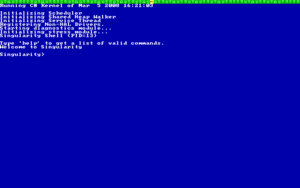
In computing, a device driver is a computer program that operates or controls a particular type of device that is attached to a computer or automaton. A driver provides a software interface to hardware devices, enabling operating systems and other computer programs to access hardware functions without needing to know precise details about the hardware being used.

In computer science, a microkernel is the near-minimum amount of software that can provide the mechanisms needed to implement an operating system (OS). These mechanisms include low-level address space management, thread management, and inter-process communication (IPC).
Mach is a kernel developed at Carnegie Mellon University by Richard Rashid and Avie Tevanian to support operating system research, primarily distributed and parallel computing. Mach is often considered one of the earliest examples of a microkernel. However, not all versions of Mach are microkernels. Mach's derivatives are the basis of the operating system kernel in GNU Hurd and of Apple's XNU kernel used in macOS, iOS, iPadOS, tvOS, and watchOS.

An operating system (OS) is system software that manages computer hardware and software resources, and provides common services for computer programs.
OS-9 is a family of real-time, process-based, multitasking, multi-user operating systems, developed in the 1980s, originally by Microware Systems Corporation for the Motorola 6809 microprocessor. It was purchased by Radisys Corp in 2001, and was purchased again in 2013 by its current owner Microware LP.
A modern computer operating system usually segregates virtual memory into user space and kernel space. Primarily, this separation serves to provide memory protection and hardware protection from malicious or errant software behaviour.

In computing, a system call is the programmatic way in which a computer program requests a service from the operating system on which it is executed. This may include hardware-related services, creation and execution of new processes, and communication with integral kernel services such as process scheduling. System calls provide an essential interface between a process and the operating system.
The Internetworking Operating System (IOS) is a family of proprietary network operating systems used on several router and network switch models manufactured by Cisco Systems. The system is a package of routing, switching, internetworking, and telecommunications functions integrated into a multitasking operating system. Although the IOS code base includes a cooperative multitasking kernel, most IOS features have been ported to other kernels, such as Linux and QNX, for use in Cisco products.
An object-oriented operating system is an operating system that is designed, structured, and operated using object-oriented programming principles.
In computing, Quark is an operating system kernel used in MorphOS. It is a microkernel designed to run fully virtualized computers, called boxes. As of 2020, only one box is available, the ABox, that lets users run extant AmigaOS software compiled for Motorola 68000 series and PowerPC central processing units (CPUs).

XNU is the computer operating system (OS) kernel developed at Apple Inc. since December 1996 for use in the Mac OS X operating system and released as free and open-source software as part of the Darwin OS, which in addition to macOS is also the basis for the Apple TV Software, iOS, iPadOS, watchOS, and tvOS OSes. XNU is an abbreviation of X is Not Unix.

The architecture of Windows NT, a line of operating systems produced and sold by Microsoft, is a layered design that consists of two main components, user mode and kernel mode. It is a preemptive, reentrant multitasking operating system, which has been designed to work with uniprocessor and symmetrical multiprocessor (SMP)-based computers. To process input/output (I/O) requests, they use packet-driven I/O, which utilizes I/O request packets (IRPs) and asynchronous I/O. Starting with Windows XP, Microsoft began making 64-bit versions of Windows available; before this, there were only 32-bit versions of these operating systems.

In computer science, hierarchical protection domains, often called protection rings, are mechanisms to protect data and functionality from faults and malicious behavior.
A hybrid kernel is an operating system kernel architecture that attempts to combine aspects and benefits of microkernel and monolithic kernel architectures used in computer operating systems.
Bartok is an optimizing compiler and managed runtime system for Common Intermediate Language, being developed by Microsoft Research.
The Mac OS nanokernel is an operating system kernel serving as the basis of most PowerPC based system software versions 7 through 9 of the classic Mac OS, predating Mac OS X.
Exec is the kernel of AmigaOS. It is a 13 KB multitasking microkernel which enabled pre-emptive multitasking in as little as 256 KB of memory. Exec provided functions for multitasking, memory management, and handling of interrupts and dynamic shared libraries.
Windows NT is a proprietary graphical operating system produced by Microsoft, the first version of which was released on July 27, 1993. It is a processor-independent, multiprocessing and multi-user operating system.

The kernel is a computer program at the core of a computer's operating system and generally has complete control over everything in the system. It is the portion of the operating system code that is always resident in memory and facilitates interactions between hardware and software components. A full kernel controls all hardware resources via device drivers, arbitrates conflicts between processes concerning such resources, and optimizes the utilization of common resources e.g. CPU & cache usage, file systems, and network sockets. On most systems, the kernel is one of the first programs loaded on startup. It handles the rest of startup as well as memory, peripherals, and input/output (I/O) requests from software, translating them into data-processing instructions for the central processing unit.







